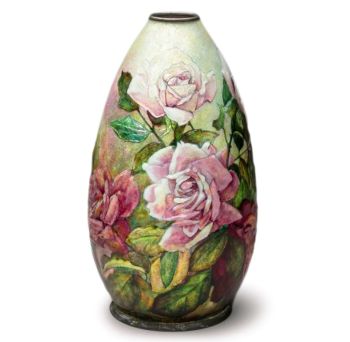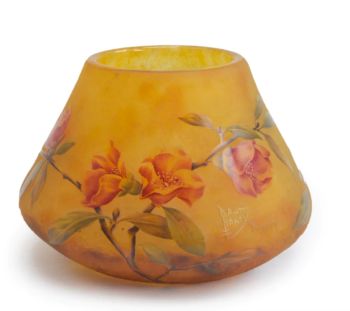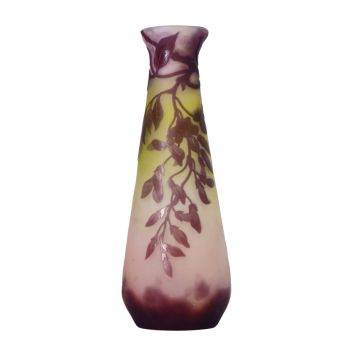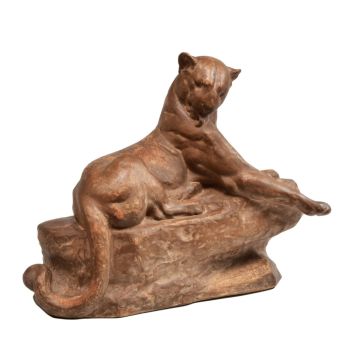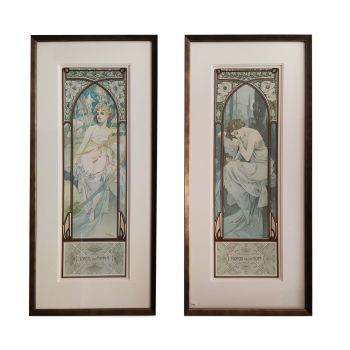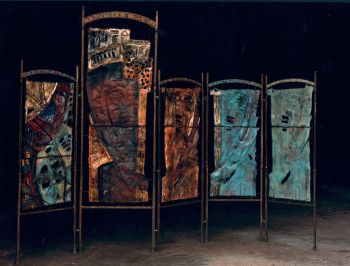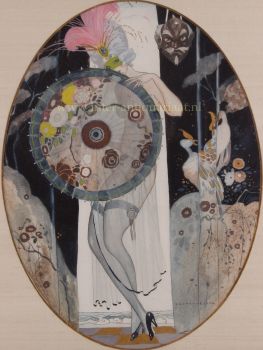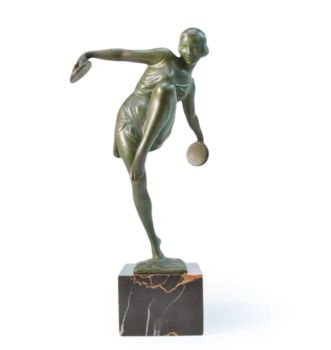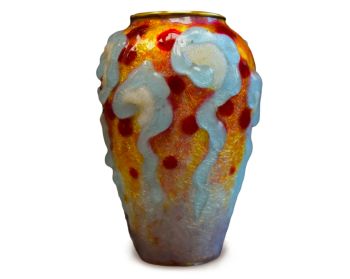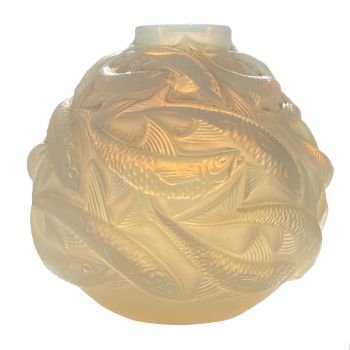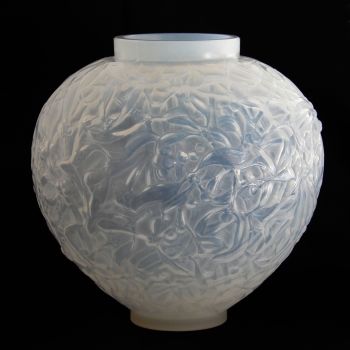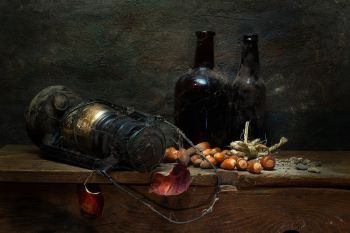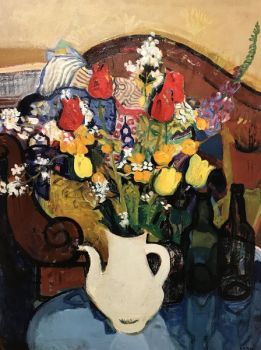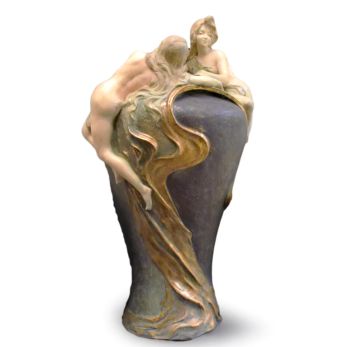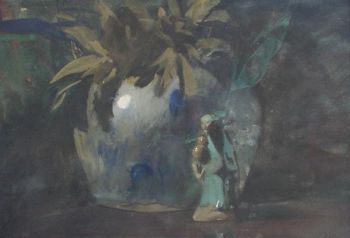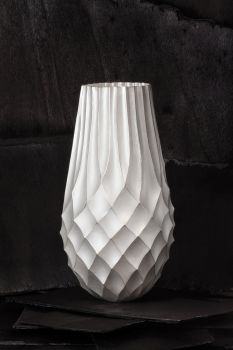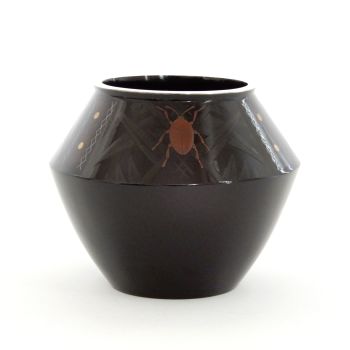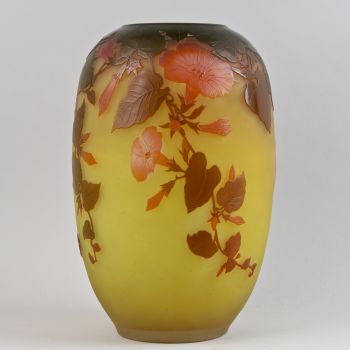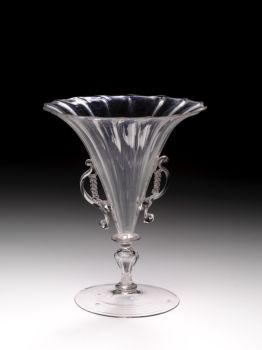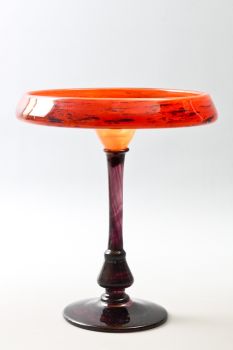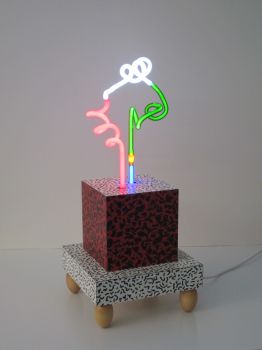Johann Loetz Witwe – Ausfuehrung 146 Titania vase – 1912 1910 - 1919
Johann Loetz (Lötz) Witwe Klostermühle
Glas
14 cm, ø 10 cm
ConditionMint
Preis auf Anfrage
Antiques Emporium
- Über KunstwerkThe Ausführung 146 vase by Johann Loetz Witwe is a stunning example of early 20th-century glass artistry, showcasing the innovative techniques and aesthetic sensibilities that defined the Art Nouveau movement, particularly within the Titania glass series. Johann Loetz Witwe, a Bohemian glassworks company, was renowned for its iridescent art glass, and Ausführung 146 is one of the exemplary executions that illustrate the company’s mastery in this “Titania” craft.
Ausführung 146 is a variation of the Titania series, which was introduced in 1905. Titania glass features an array of vibrant color combinations. Each piece showcases intricate patterns crafted from steel-gray glass threads, which are applied over the colored base. These patterns categorize the pieces into distinct types of Titania glass. The final touch involves encasing each piece in a layer of clear glass, enhancing its overall elegance.
The creation of a vase in Ausführung 146 requires a high level of skill and precision. The process begins with selecting high-quality glass, which is then blown and shaped by hand. The artisans at Johann Loetz Witwe were known for their expertise in manipulating glass to create intricate designs and textures. - Über Künstler
Etwas mehr als hundert Jahre existierte die Glashütte Lötz in Klostermühle, Österreich, ab 1840. Ihre Blütezeit erlebte sie jedoch zu Lebzeiten von Max Ritter von Spaun, dem Enkel des ursprünglichen Gründers Johann Lötz.
Von Spaun übernahm 1879 das Unternehmen und führte es bis 1908, ein Jahr vor seinem Tod. Er wurde von seinem technischen Spezialisten Eduard Prochaska unterstützt, und gemeinsam erfanden, entwarfen und produzierten sie eine ganze Reihe wunderbarer neuer Glasarten, erwarben mehrere Patente und gewannen Preise auf allen großen Weltausstellungen in den 1890er Jahren und in den ersten Jahren des 19. das neue Jahrhundert.
Die Firma Loetz gehörte zu den Vorreitern im Jugendstildesign und insbesondere im Bereich des schillernden Kunstglases. "Papillon"-Glas, wie die Vase links, wird heute manchmal als "Ölfleck"-Glas bezeichnet. Eine weitere beliebte Farbe von Loetz war bestrahltes Glas mit gezogenen Spuren, das als "Phenomenon" -Glas bezeichnet wird.
Es gab irritierte Vasen mit Bändern in Metallic-Farben, die sich über die Oberfläche schlängelten, und viele spektakuläre Designs mit applizierten Pfaden in schönen Farben oder einfach aus dem Glaskörper herausgezogen, um Griffe oder Dekorationen zu bilden.
Um 1900 begann das Unternehmen mit externen Designern zusammenzuarbeiten, und einige große Künstler entwarfen Stücke für Lotz, insbesondere Joseph Hofmann, Koloman Moser, Maria Kirchner und Hofstatter.
1908 wurde Loetz von Max von Spauns Sohn, auch Max genannt, übernommen, und obwohl es finanziell zu kämpfen hatte (Konkurs 1911 und erneut 1931), gab es mehrere große Designer, deren Arbeiten in diesen Jahren und durch die Kunst von Loetz produziert wurden Deko-Zeit. Dazu gehörten Adolf Beckert und Michael Powolny.
Sind Sie daran interessiert, dieses Kunstwerk zu kaufen?
Artwork details
Related artworks
Johann Loetz (Lötz) Witwe Klostermühle
Johann Loetz Witwe – Jugendstil Cobalt Papillon vaas1900 - 1910
Preis auf AnfrageAntiques Emporium
Johann Loetz (Lötz) Witwe Klostermühle
Johann Loetz Witwe - Phänomen Genre 7773 – Orange1900 - 1910
Preis auf AnfrageAntiques Emporium
1 - 4 / 7- 1 - 4 / 24
- 1 - 4 / 24
Unbekannter Künstler
François-Théodore Legras – Tall “Fleurs de Pommier” apple blossoms vase1900 - 1909
Preis auf AnfrageAntiques Emporium
Jan Voerman sr
Still Life with flowers in a Chinese figurine1850 - 1900
Preis auf AnfrageKunsthandel Pygmalion
Gabriel Argy-Rousseau
Gabriël Argy-Rousseau – Crabes et Algues vase – 19201920 - 1929
Preis auf AnfrageAntiques Emporium
Unbekannter Künstler
A Japanese bronze Hu flower vase, Edo / Meiji, 19th century19th century
Preis auf AnfrageMenken Works of Art
Herman Bogman jr.
Flower still life of a nasturtium in a blue vase1950 - 1965
Preis auf AnfrageAdelwein Kunst
Unbekannter Künstler
Japanese art deco lacquervase with Scarab beetle motif1920 - 1950
Preis auf AnfrageDille Art
1 - 4 / 24Unbekannter Künstler
Venezianisches geflügeltes Glas1550 - 1599
Preis auf AnfragePeter Korf de Gidts - Antiquairs
Unbekannter Künstler
Ein seltenes Filigrana, ein Retortoli-Becher1550 - 1600
Preis auf AnfragePeter Korf de Gidts - Antiquairs
1 - 4 / 24Johann Loetz (Lötz) Witwe Klostermühle
Johann Loetz Witwe – Jugendstil Cobalt Papillon vaas1900 - 1910
Preis auf AnfrageAntiques Emporium
Amalric Walter
Amalric Walter & Henri Bergé – Crabe plumier1920 - 1929
Preis auf AnfrageAntiques Emporium
Frères Daum
Daum Nancy – “Paysage Soleil Couchant” vase with two applied handles1900 - 1910
Preis auf AnfrageAntiques Emporium
Johann Loetz (Lötz) Witwe Klostermühle
Johann Loetz Witwe - Phänomen Genre 7773 – Orange1900 - 1910
Preis auf AnfrageAntiques Emporium
Unbekannter Künstler
François-Théodore Legras – Tall “Fleurs de Pommier” apple blossoms vase1900 - 1909
Preis auf AnfrageAntiques Emporium
Demetre Chiparus
Demetre H. Chiparus – Bronze Art Deco statue “Rapture” – Édition Etling, Paris1920 - 1929
Preis auf AnfrageAntiques Emporium
Gabriel Argy-Rousseau
Gabriël Argy-Rousseau – Crabes et Algues vase – 19201920 - 1929
Preis auf AnfrageAntiques Emporium
1 - 4 / 12




















